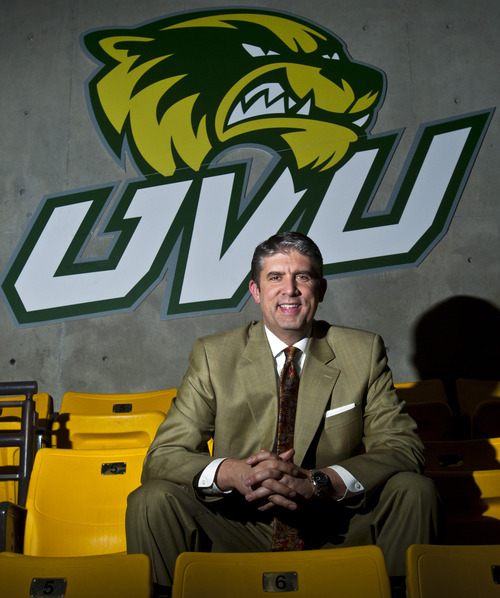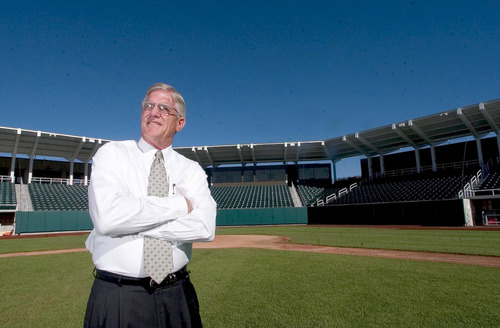This is an archived article that was published on sltrib.com in 2013, and information in the article may be outdated. It is provided only for personal research purposes and may not be reprinted.
Orem • Twenty-nine years ago, Utah Valley Community College President J. Marvin Higbee directed his new athletic director to create an athletics program in the image of Snow College.
Three decades later, Michael Jacobsen, on the verge of retirement, can look out over what was once swampland and enjoy the fruits of his labor, an effort that has extended Utah Valley University's athletic program well beyond Higbee's original vision.
On July 1, UVU becomes a full-fledged member of the Western Athletic Conference, the culmination of a long, sometimes twisting endeavor begun when the school committed to transition from a junior college to a four-year Division I institution.
Now comes the difficult part. What will the next 10 or 20 years bring?
"That's a hard answer," said Jacobsen, who retires in July. "It's going to be in a great place. Without football, without having that driver behind you … I look at us being a Gonzaga. I look at us being a Butler, a school that can make a big splash, to grow and do something good."
"We still have not reached our potential. We still have some real nice things to do."
The move to the WAC finally places UVU in a conference that automatically sends teams to NCAA tournaments. The Wolverines' new status already has impacted recruiting.
"We're moving past the door to recruiting and taking a couple steps down the hall," UVU basketball coach Dick Hunsaker said.
In many ways, though, hard work remains, especially in funding a Division I program. Expectations are that being in the WAC will boost attendance, increase concessions and create new financial partnerships within a community under the large shadow of Brigham Young University.
UVU's current athletic budget is about $9 million, which is $4 million less than Weber State University's.
"We've got to develop a source [of funding] that's different from what we get from student fees and different from what we get from appropriated dollars," Jacobsen said.
Finding more dollars is the key to any successful program. Jacobsen's successor, Vincent Otoupal, also will have to deal with the lowering of the age students can embark on missions for The Church of Jesus Christ of Latter-day Saints.
The future, however, also holds television dollars, a new money stream, as well as something no other in-state public school can match.
"We're set for a fairly significant growth in student fees," UVU President Matthew Holland said. "Given that we don't have a football program, student fees are good for what we want to do."
By the end of the decade, UVU is projected to have nearly 43,000 students, making it the largest public university in Utah.
"If we reach that level, it will be a real game changer for our revenue," Holland said.
The day in early October 2012 when UVU learned it would join the WAC was a celebratory day. WAC logos blanketed the UCCU Center. Giddy spectators and school officials wore WAC-stamped clothing.
Yet, some of the first questions offered that day referenced football, as in will UVU ever have a football team?
"There's not been a single day go by since I've been here that someone hasn't mentioned football," Jacobsen said. "Because we don't have it, we'll always be considered second class. Even when we make it to the [NCAA basketball tournament] it will still be, 'They don't have football.' "
There have been several small windows during Jacobsen's 29 years in which football might have become part of UVU. The last came several years ago when Utah Valley and the Big Sky Conference danced around each other.
The Big Sky said no football, no UVU.
Utah Valley said let us in and in three years we'll have football. For now, though, the window is closed.
"I don't ever want to take it off the table, but in the short term, it doesn't make sense," said Holland, listing revenue eaters such as scholarships, coaches' salaries and a venue in which to play.
"I know the students would be enthusiastic … [but] during my term, probably not."
Not everyone is enamored with football.
"That's a whole other ball game," said former Utah Jazz guard Ronnie Price, UVU's most famous athletic alum, who keeps tabs on school progress. "A lot of schools that don't have football compete on the D-1 level."
Utah Valley was a junior college when Price started playing for Hunsaker as a sophomore. The school began its transition to Division I status the next season.
Now, men's basketball is the school's showcase, which brings its own pressures and expectations.
"The [WAC] is a big deal," Price said. "To be there when we were fighting for a JUCO championship and now be Division I in a notable conference is saying a lot for what the university and its representatives have done."
Hunsaker, who has had past success at Ball State and Utah, certainly knows what is ahead. He's now competing with New Mexico State and not the New Jersey Institute of Technology. He took the position knowing this day would eventually come.
"Our ability to compete is more of a long-term problem," he said. "We want to push forward in a responsible manner. I speak for all of our coaches.
"Overall, this is a wonderful time."
Twitter@tribmarty —
Utah Valley University growth chart
1941 • Opens as Central Utah Vocational School.
1967 • Renamed Utah Technical College.
1977 • Moves to present location next to Interstate 15.
1987 • Renamed Utah Valley Community College.
1993 • Renamed Utah Valley State College.
2000 • Women's softball team wins NJCAA title.
2002-03 • Begins seven-year provisional steps toward Division I status.
2003-04 • Teams begin competing with partial Division I schedules.
2005 • Ronnie Price is named Division I Independent Basketball Player of the Year.
2007 • Renamed Utah Valley University.
2008 • Joins Great West Conference.
2009 • Becomes full-fledged member of the NCAA.
2011 • Wrestler Ben Kjar becomes school's first All-American.
2012 • Men's basketball team is selected to first postseason tournament, the CIT.
2013 • Joins the Western Athletic Conference.
2014 • Men's soccer program begins. —
UVU facilities
• UCCU Center (men's and women's basketball), seats 8,500
• Activity Center (women's volleyball, wrestling)
• Brent Brown Stadium (baseball)
• Hal Wing Track
• Wolverine Field (softball)
• Clyde Field (men's and women's soccer)





